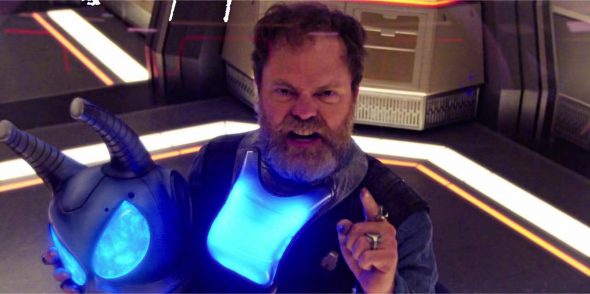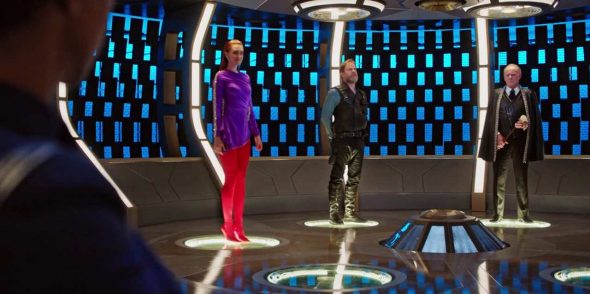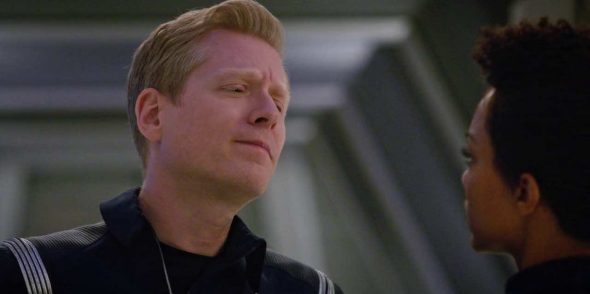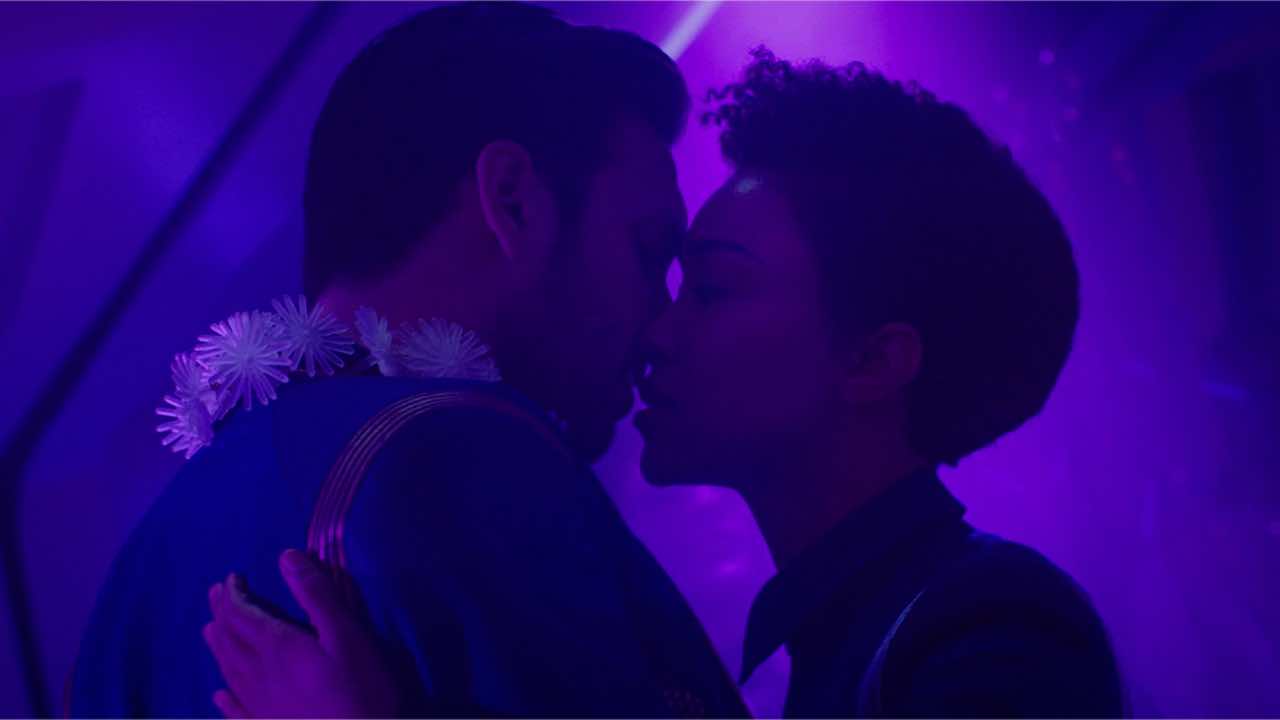First things first. Star Trek: Discovery is set in something like 2245. The music that’s playing at the party is Wyclef Jean’s “We Trying to Stay Alive,” from 1997.
Which is the equivalent of going into a party on a modern aircraft carrier where the crew are getting down to this, one of the hottest bangers of 1769.
I’m not even really complaining: this is basically an impossible problem to solve. When movies DO try to imagine future pop culture (like the party scene in Starship Troopers), the results are usually even worse. And respect to the music editor for putting the part where ‘Clef’s like “Now you shook up, shook up/ ‘cause you lock up, lock up/ when I love up, love up” under the part where Burnham awkwardly fails to flirt with Tyler.

Get to the point, Stokes!
Anyway, on to the meat of the episode. Harry Mudd is back, and he has something called a time crystal that lets him set up a 30-minute time loop. He also has a couple of really powerful explosives. His plan is to infiltrate the ship and gradually learn how to hijack its core systems, with the goal of eventually selling it to the Klingons. Every time he gets caught or hits a dead end, he blows up the ship and activates the time loop, and then starts over knowing juuust a little more than he did last time, making this episode basically Edge of Tomorrow but told from the perspective of the aliens. The fly in Mudd’s ointment is Lieutenant Stamets, who — due to spore-related trauma — sort of doesn’t live inside three-dimensional spacetime any more. Last episode we got a creepy teaser of this, this time it has the convenient effect of letting him remember events across time loops.
“Magic to Make the Sanest Man Go Mad” is the most speculative-fiction-y episode we’ve had so far! At the start of the episode, it sets up a scifi premise: the time loop. Then it works out the consequences of that loop with something approaching logical rigor. If that, and this, then what? This kind of thing has been notably absent on Disco Trek up to this point, and I for one was glad to see it make an appearance.
There are a couple of little gaps, mind you. If Stamets is the only character who can transport information through the time loop, then it’s a really big deal when, on one loop, Mudd decides to interrogate him, and beams the two of them off to engineering! But Burnham figures out and/or realizes some really important information after that, and acts like she still knows it on the next iteration. Now, presumably she could have run to engineering, found Stamets, and told him everything before she went to confront Mudd. And maybe we’re just supposed to assume that that happened. I can even understand why they didn’t bother to shoot this scene: nothing really interesting is happening there, so maybe it’s like bothering to shoot all four passengers unbuckling their seatbelts before they get out of a car. But leaving the scene out betrays a certain lack of respect for the gimmick. If you really take the time loop seriously, then Stamets is like a save point in an old RPG: you HAVE to check in with him before you do anything that might get you killed.
Another problem — not a contradiction, but still a problem — why does Mudd need to blow up the ship AT ALL? At first it seems like the explosion from his little handheld detonator is what triggers the time loop, but we see him blowing up the ship in a handful of different ways. Can’t he just leap back by activating his wristband? Actually, I think he does need to explode: even on the last reset, where Burnham forces his hand, he blows he ship up. But when they’re talking about time crystals, why not have a line where Burnham’s like: “If the crystal’s integrity is destroyed by a powerful force, like an explosion, it reverts to its most recent stable spatiotemporal node.” This is a hand-wave, sure, but if you really care about working out the consequences of your premise, you’ve got to cross those t’s and dot those i’s.
My final quibble is not a sci-fi nerd problem, but a storytelling nerd problem. What’s with the weird tonal disconnect at the end of the episode? When they finally take Mudd down, they deliver him into the custody of his clingy fiancée and her scary arms-dealer father. She’s like, “Oh, I’ll never let him out of my sight again,” and Mudd grimaces a little. This is kind of a hacky (and misogynist) joke, but the real problem is that it feels like a punishment fit for the TOS Harry Mudd. The old Mudd was a ne’er-do-well and a conman. This Mudd is a traitor to his species, a war profiteer, and a gleefully murderous sociopath. I don’t mind these changes to the character — the Lorca murder montage was a treat! But if you’re going to make that change, follow through on it. Do you really punish Mudd 2.0 by forcing him to settle down and get married?

Stella and her dad even look like refugees from The Original Series, come to think of it.
Okay, enough complaining. Let’s talk about what the show did right. The most obvious point of comparison here is the TNG episode “Cause and Effect,” which did the stuck-in-a-time-loop gimmick way back in 1992 (a full year before Groundhog Day, although more than seventy years after The Shadow did it in “The Man Who Mudered Time”). It would be unfair to call “Magic to Make the Sanest Man Go Mad” a retread of “Cause and Effect,” though — they are kind of profoundly different in the way that they handle the gimmick. In “Cause and Effect,” pretty much everyone becomes aware of the time loop. They all start having deja-vu, hearing weird voices, noticing that they can predict seemingly random events. Nobody has to spend any time convincing other people that a time loop is happening: they all know something is wrong, and then they figure it out together. In Discovery, convincing people eats up most of the screen time! First Stamets has to convince Burnham, then Burnham has to convince Tyler… we don’t actually see them convince Lorca, but knowing what we know about Lorca we can imagine that it took a while. Now, the one person they don’t really have to convince is Tilly. We catch the tail end of that conversation, and it seems like it consisted of Burnham telling her “there’s a time loop, sober up and head to the shuttlebay, we need you to do some competent space stuff.” And then — while Tilly is doing the competent space stuff, because she gets that the problem is urgent — Tilly is like “wow, so a time loop where everyone gets killed… so that means I died, too? Crazy! Also, I totally trust your account of this bonkers scenario.”
Why didn’t TNG make one of their characters try to convince everybody else that there’s a time loop? There are some cool puzzle-box plots to explore down that road! When Stamets is like, “you have to tell me a secret you’ve never told anyone, so next time you’ll know we’ve had this conversation before” that is a genuinely cool moment! But TNG can’t do this, because, and this is important, every character on Star Trek: the Next Generation is Cadet Sylvia Tilly. If Worf showed up on the bridge and was like, “Captain, I know this is going to surprise you, but we seem to be stuck in a time loop,” Picard would get up from his chair and give him a hug, and then say “Obviously you are telling the truth, and I validate your experience. Now tell me how we fix this thing.” It would be a non-plot! Much better to have the whole crew experience deja-vu all together, just to get it out of the way.
But on Discovery, nobody trusts anybody.And so the process of escaping the time loop consists precisely in establishing trust between the members of the crew. And not in the stupid action movie way, where one charater is just like “You have to trust me! You have no choice!” and the other’s like “… okay, fine, I’d prefer it if the writers had given me an actual reason to trust you but fine.” Like, you get the feeling that Stamets tried just shouting at Burnham, maybe a whole bunch of times? And it didn’t work. That’s not really how trust is established, you know? So instead, the characters need to have squishy conversations about their feelings, and reminisce about meeting their lovers, and give each other dancing lessons, and smooch, and — reader, I was into it.

You know, pathos. And whatnot.
And this kind of squishy character stuff is, in a significant way, what Disco Trek is all about. It’s part of the melodramatic streak that I was talking about in the last of these things that I wrote. Note how the log entries in this franchise are not Captain’s Logs, but Personal Logs — and that, rather than re-hashing the ship’s current location and mission objectives, Burnham mostly talks about how she feels about the rest of the crew. If the old-school Trek is about exploring scientific and moral possibilities, maybe Disco Trek will turn out to be about exploring emotional possibilities?
Of course, most of the character development in this episode is only temporary. Once they finally manage to defeat Mudd, Stamets is the only one who remembers all of it — and so a lot of that character development is lost in the winds of spacetime. Still, the inescapable message is that the Discovery crew can learn to trust each other, and that — when they do — they can accomplish miracles.
Random Notes
- There’s this interesting thing going on with Tilly, where her obnoxiousness level is directly correlated with how tightly done up her hair is? (I’m pretty sure this is actually a combined writing/acting/makeup choice, and not me giving her more of a pass when they’ve made her look prettier.)
- The title, “Magic to Make the Sanest Man Go Mad,” is a reference to the Iliad, where it refers to — I think — Aphrodite’s bra? Which Hera borrows from her in order to sex up Zeus, so that he’ll be distracted and Poseidon can intervene in the battle on behalf of the Greeks? (Keep in mind, depending on which myth you follow, Aphrodite is either Zeus’s daughter or sort of his aunt, so I bet that convo with Hera was super comfortable.) Anyway, this is vaguely on point in that somebody is trying to engineer a romantic entanglement as a step in some kind of complicated military plan. But I would have just called it “Stayin’ Alive.”
- ARE YOU KIDDING ME with that on-the-nose “
space pandasGormaganders are too driven by their careers to fuck” line.

The thing I can’t quite get my head around is how you get from Mudd 2.0 to TOS Mudd in 10 years. It seems like almost a devolution of the character. Either Stella is a better influence on him than he realizes or somewhere in the interim he *really* hits bottom.
At the risk of stating the obvious, I think this is the first overt reference to the musical genre “disco” after the “DISCO” t-shirts made their debut a few episodes ago. It’s a nice touch, even though the whole “disco in space” thing was already done recently in The Martian. Still, I hope there’s one of those great Star Trek scenes where either one of the characters or the computer has to explain disco in very basic terms to a crewmember. “Disco was a popular genre prevalent in the late 20th century on Earth,” etc. etc. etc. And maybe the crew all dresses as the Village People and visits Studio 54 on the holodeck.
Side note, there’s a holodeck on this ship.